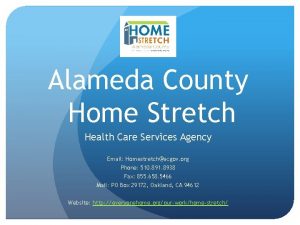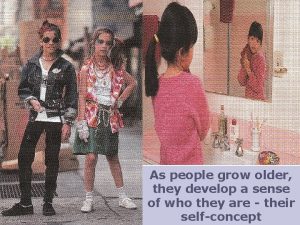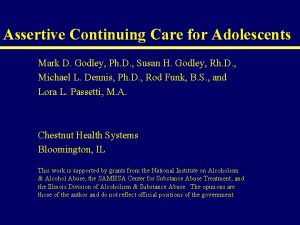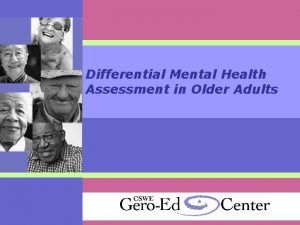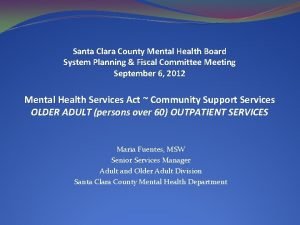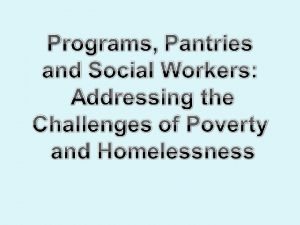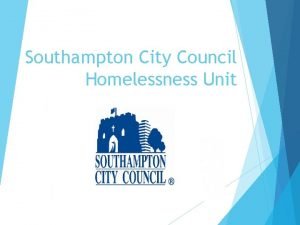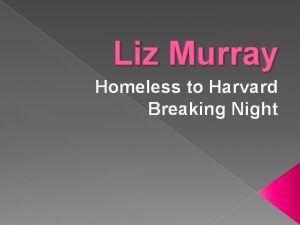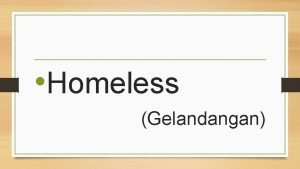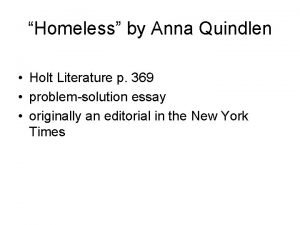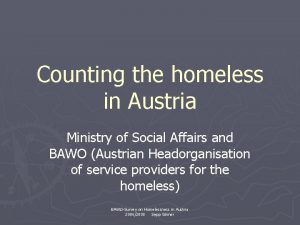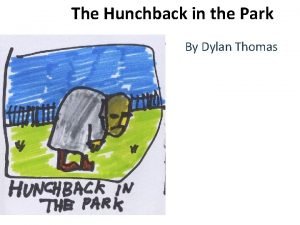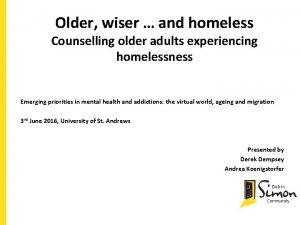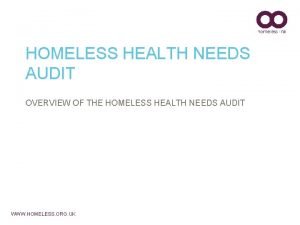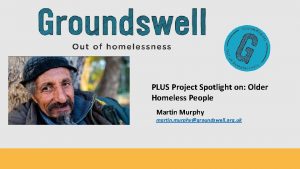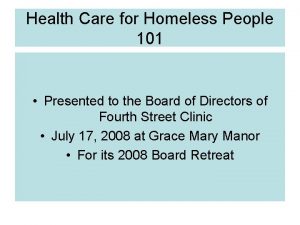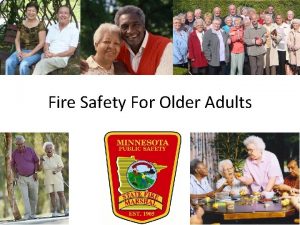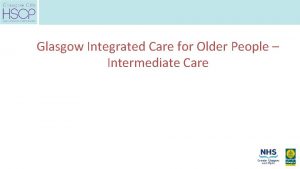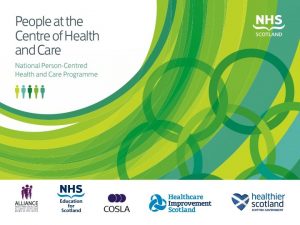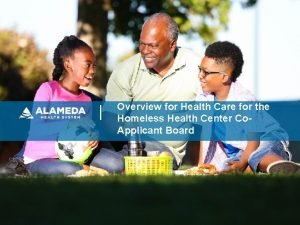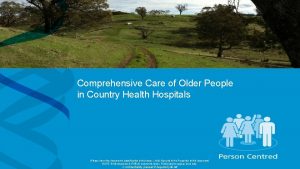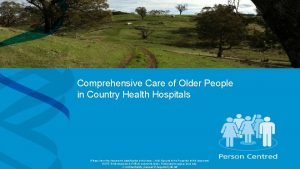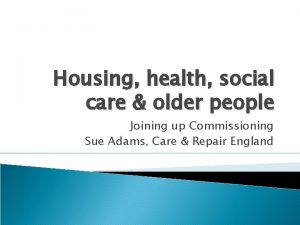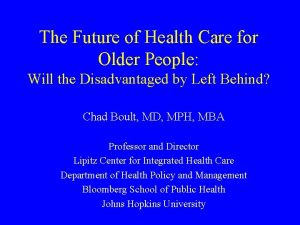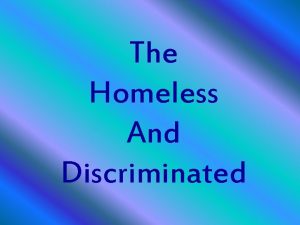Older Homeless People meeting their continuing health care




















- Slides: 20

Older Homeless People – meeting their continuing health care and support needs Sarah Gorton UK Coalition on Older Homelessness

Homeless Link manages: l l Homeless Link National membership agency for organisations working with homeless people UK Coalition on Older Homelessness - a project aimed at raising awareness of the needs of older homeless people and improving services

Case study -Tom l l l Became homeless in forties when marriage ended. Slept rough and in hostels frequently evicted, aggressive behaviour linked to heavy drinking. Liver failure, severe anaemia, needs prompting with personal hygiene, eating and medication. Assessed and placed in residential care, could not settle and left. Highly vulnerable-multiple interacting physical and mental health and alcohol problems.

Numbers and definitions: l l l In relation to homeless people, due to premature ageing issues, we tend to define older people as those over 50 years of age. People who have been long term homeless have often sustained lasting damage to their health through their life style and/or alcohol dependence In the 1990’s the average of death for a rough sleeper was 42 years

Numbers: There an estimated 42, 000 older homeless people in the UK. This figure covers: 1. People over the age of 50 who are sleeping rough - an estimated 300 (in England. ) 2. Hostel dwellers- an estimated 5, 000 3. People living in Bed and Breakfasts, an estimated 12, 000 4. An official number of 4, 420 people accepted as statutorily homeless and vulnerable due to old age 5. People about to be discharged from prison or hospital with nowhere to go.

Health problems: November 2004 St Mungo’s survey of rough sleepers and those in hostels over 50 years of age: l 56% are alcohol dependent l 48% have mental health problems l 47% have physical health problems l 27% have challenging behaviour

Social exclusion l l The majority of older homeless people have a combination of those issues, with 43% having 4 or more problems. 74% had no next kin of details Of 36% who are known to be parents 52% have no contact with their children. 23% have no social network

Access to health issues: Tudor Hart first described the inverse care law in 1971. It states that the availability of good medical care tends to vary inversely with the need for it in the population served. Unfortunately despite the current emphasis on addressing inequalities in health this still holds true for the homeless population. Tudor hart J (1971) The Lancet 405 -12

Access to health issues: There a number of interlinked factors; l l lack of understanding and awareness on the part of GP practices, discrimination and prejudice, a mistaken belief that people need a permanent address in order to register with a GP A lack of resources and training to address the complex problems presented by homeless people with complex needs Homeless people’s difficulty in using mainstream services, due to low self-esteem, expectation of rejection and difficulty in keeping to appointments.

Hospital discharge: l l Research with homeless people over the age of 50 years in Manchester showed a hospital admission rate three times greater than the national average for people between the ages of 65 – 79 years, despite the fact that the average of the homeless group was 16 years lower. Research in Bristol found a highly increased rate of readmission in patients living in hostels (35%) to those being admitted from their own home (10%)

What are the solutions? :

Policy level: For the first time ever health inequalities were made a Key priority for the NHS in the priorities and planning framework for 2003 – 06. This emphasis puts Public Health and partnership working with local authorities and local communities at the centre of PCT concerns. Homeless people were identified in the Cross Cutting review on tackling Health Inequalities as one of the vulnerable groups for whom specific actions must be identified if life expectancy targets are to be reached.

Social Exclusion Unit report ‘ A Sure Start to Later Life’ has recognised that l Older homeless people face severe challenges in accessing accommodation in which they feel safe and supported. l There is a need for specialist accommodation for the older homeless population l There is a need for improved practice on the discharge of homeless people from hospital and for access to appropriate intermediate care.

Auditing the Older Homeless population l l The COHP are developing a methodology for use by local authorities to audit the numbers and needs of older homeless people in their area. This is first step to getting improved recognition of their specific needs from Supporting People, PCTs and Social Services

Sheltered housing and Extra care housing Access to sheltered housing with appropriate support l Remodelled specialist sheltered housing schemes specifically for this client group l Extra care housing for those with the most complex needs l

Extra care and older homeless l l l Extra care is a solution we would like to see applied to older homeless people with more complex needs. Independent accommodation Company and support Care needs met in flexible manner Developed by RSLs working with homeless or specialist units within a scheme

Intermediate care and homeless people l l High rate of hospital admission, self discharge and re-admission Hostels not suitable environment to return to Mainstream intermediate care does not work for client group Need for specialist service to provide ongoing health care and rehab support

Joint commissioning: The needs of older homeless people cross health and social care and housing support boundaries. Service criteria, lack of access to community care funding and local authority local connection rules tend to put barriers in the way of effectively delivering services to people with multiple needs who are also mobile. Joint commissioning and cross authority commissioning are under-developed but they do offer the possibility to develop integrated and holistic services for this client group.

Homeless people are not “the problem”, but must be part of the solution! Homeless people have much to say about the way they experience services and it is important to find ways to listen and to respond to those experiences.

Contact details UK Coalition on Older Homelessness www. olderhomelessness. org. uk sarah. gorton@homelesslink. org. uk Tel 0207 960 3057
 Life is older older than the trees
Life is older older than the trees Homestretch alameda county
Homestretch alameda county As people grow older
As people grow older Assertive continuing care
Assertive continuing care Mental health and older adults
Mental health and older adults Mental health and older adults
Mental health and older adults Older adults mental health
Older adults mental health Primary secondary tertiary care
Primary secondary tertiary care Care value base health and social care
Care value base health and social care Health and social care component 3
Health and social care component 3 For today's meeting
For today's meeting Meeting objective
Meeting objective What is meeting and types of meeting
What is meeting and types of meeting Types of meeting
Types of meeting Will smith movie homeless
Will smith movie homeless Southampton city council homeless
Southampton city council homeless Homeless to harvard questions
Homeless to harvard questions Homeless artinya
Homeless artinya Homeless by anna quindlen
Homeless by anna quindlen Homelessness in austria
Homelessness in austria Hunchback in the park
Hunchback in the park

